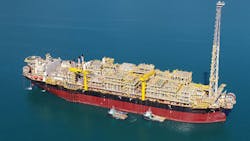Petrobras updates pre-production, ramp-up programs for latest FPSOs
Offshore staff
RIO DE JANEIRO, Brazil — Petrobras has issued a progress report on expansion activity at four producing deepwater fields.
Two will receive new FPSOs that recently departed Chinese shipyards.
The Anna Nery platform, with an oil production capacity of 70,000 bbl/d, left the Cosco Qidong shipyard on July 8, and is heading for the city of Angra dos Reis, Rio de Janeiro State, for completion of commissioning and preliminary acceptance tests.
Anna Nery and the Anita Garibaldi FPSO are central to the Marlim and Voador revitalization project in the Campos Basin. They will replace nine platforms at these fields: four remain in operation (P-18, P-19, P-20 and P-47) with the other five in the decommissioning phase (P-26, P-32, P-33, P-35 and P-37).
The new FPSO was designed according to Petrobras’ "All Electric" concept, which envisages maximizing the use of electricity to power equipment, reducing carbon emissions at the Marlim Field.
Malaysian company Yinson, which constructed the facility, will also operate on a charter basis.
FPSO Almirante Barroso sailed from the Cosco Dalian shipyard in China last weekend, again bound for Angra dos Reis to undergo a similar program, plus regulatory inspections.
The 150,000-bbl/d platform, contracted with MODEC, will be the first leased unit at the giant Búzios Field in the presalt Santos Basin and the fifth in production, following P-74, P-75, P-76 and P-77.
Elsewhere in the presalt Santos Basin region, FPSO Carioca—recently onstream at the Sépia Field—ramped up production to 155,000 bbl/d, with the P-68 reaching full capacity on June 21.
And the Guanabara FPSO, which started operating at the Mero Field in the Libra Block at the end of April, completed its first oil offloading (500,000 bbl) on May 31. The platform has capacity to process up to 180,000 bbl/d of oil and 12 MMcm/d of gas.
Earlier this month, gas injection started. This reduces flaring, enabling sequencing of the platform's ramp-up, in compliance with regulations.
07.22.2022
